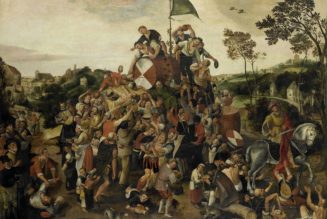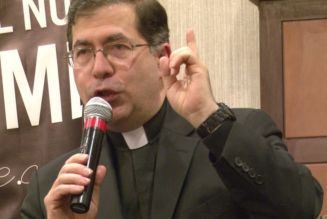By Dr. Jeff Mirus ( bio – articles – email ) | Aug 13, 2024
St. Augustine, who was trained in the heights of the Latin rhetorical tradition, found Scripture rhetorically primitive when he was looking at it from the outside, before his conversion. But he became far more impressed with the rhetorical power of both the Old and the New Testaments once he began to grasp their inner meaning. There are in fact many different rhetorical flourishes in Scripture, and some of the most satisfying of them employ what we might call “sequences” of various kinds. Indeed, rhetorical sequences seem to play an important role in most languages—such as the common habit of ending a speech with a triad of phrases, as Abraham Lincoln did in the Gettysburg Address: “Government of the people, by the people, for the people, shall not perish from the earth”.
There are a number of different kinds of sequences in Scripture. Perhaps the most fundamental are the sequences of seven, which was a Hebrew word with the same consonants as the word for “completeness” or “wholeness”. Consider, for example, the seven days of Genesis and the seven churches, seven seals, and the seven trumpets of the Book of Revelation. But almost wherever we turn in Scripture, we encounter rhetorical sequences of various kinds, sometimes involving specific numbers, but also highlighting the unfolding of events, the connection between multiple concepts or ideas, or the nature of the Divine gifts.
One simple and traditional Jewish form of sequential expression is found in chapter 30 of the Book of Proverbs, which repeatedly delights in the Hebrew trope of superabundance, a trope which adds one more to a group of things to make a point. An example: “Three things are stately in their tread; four are stately in their stride: the lion, which is mightiest among beasts and does not turn back before any; the strutting rooster, the he-goat, and a king whose army is with him” (30:29-31).
Just as we do in our own writing and speeches, the sacred writers in Scripture use various kinds of rhetorical sequences to heighten the power of important passages. These are, of course, also quite common in any form of poetry. When it comes to the Bible, it is hard not to think of what are probably the two most famous rhetorical sequences in all of Scripture. As I already mentioned, right from the beginning of the Old Testament, we have the astounding account of the seven days of the Creation of the world. But even more moving is St. John’s account of the deeper reality which underlies Creation itself. The famous prologue to his Gospel opens this way: “In the beginning was the Word, and the Word was with God, and the Word was God”—a threefold expression which sets the stage for the initiation of the entire Divine sequence of human salvation.
Looking back again, we find that in the Old Testament Our Lord is often prefigured in the personification of wisdom. In the following sequential passage from the Book of Wisdom, we see human wisdom as ultimately rooted and finding fulfillment in Divine Wisdom:
The beginning of wisdom is the sincerest desire for instruction, and concern for instruction is love of her, and love of her is the keeping of her laws, and giving heed to her laws is assurance of immortality, and immortality brings one near to God; so the desire for wisdom leads to a kingdom. [Wis 6:17-20]
Other famous rhetorical sequences
Among the various poetic or near-poetic verbal sequences which we find in the New Testament, three others come readily to my own mind. First, there is James’ emphasis on the relationship among wisdom, justice and peace: “[T]he wisdom from above is first pure, then peaceable, gentle, open to reason, full of mercy and good fruits, impartial and sincere. And a harvest of justice is sown in peace by those who make peace” (Jas 3:17-18). This passage has always interested me because I have always held in my mind the adage, “If you want peace, work for justice”, which perhaps prioritizes specific acts over deeper dispositions. But St. James reverses that concept here, emphasizing the importance of remaining at peace with God, ourselves and others as a kind of basis for fostering justice (or, in some translations, righteousness)—which prompts reflection.
And of course there is St. Paul’s brilliant sequence on love which occupies the entire thirteenth chapter of his first letter to the Corinthians. I have excerpted it here: “If I speak in the tongues of men and of angels, but have not love, I am a noisy gong or a clanging cymbal…. Love is patient and kind; love is not jealous or boastful…. Love bears all things, believes all things, hopes all things, endures all things…. So faith, hope, love abide, these three; but the greatest of these is love.”
Paul also explains in his letter to the Romans “that for those who love God all things work together for good, for those who are called according to his purpose.” He goes on to express this more fully in yet another great rhetorical sequence:
For those whom he foreknew he also predestined to be conformed to the image of his Son, in order that he might be the firstborn among many brothers. And those whom he predestined he also called, and those whom he called he also justified, and those whom he justified he also glorified. [Rom 8:28:30]
This may require a bit of care to avoid an erroneous understanding, as is quite common in Scripture. Indeed, fundamentalists are wrong in their supposition that Scripture reads like a crystal-clear twenty-first century news story written in ninth-grade English. And of course it is partly the rhetorical flourishes which require caution. In this case the passage presupposes human cooperation for its fulfillment in each person’s life. Yet this rhetorical sequence expressing God’s action, when we consider the salvation history which these pregnant phrases encapsulate, is nothing short of astonishing.
Many more examples could be cited of the effective use of this and other kinds of literary techniques. There is great beauty and rhetorical power in Scripture, for all the difficulty St. Augustine had initially, when he first adversely compared his ignorant reading of the Biblical books with his deep knowledge of the classical Latin texts. In our case as well, we have generally been taught more thoroughly about everything else than we have about Scripture. For this reason, and for many other even more important reasons, we ought to read Scripture regularly—and savor the opportunity to think about ourselves, our Church, and our Savior in Scriptural terms. In this task we will be assisted wonderfully by an appreciation for Scripture’s engraced rhetorical power.
Sound Off! CatholicCulture.org supporters weigh in.
All comments are moderated. To lighten our editing burden, only current donors are allowed to Sound Off. If you are a current donor, log in to see the comment form; otherwise please support our work, and Sound Off!

There are no comments yet for this item.










